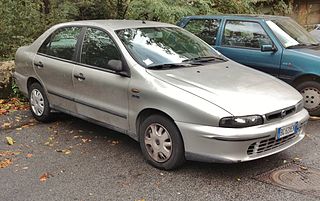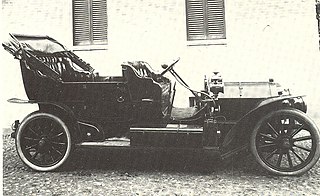
Dino was a marque best known for mid-engined, rear-drive sports cars produced by Ferrari from 1957 to 1976. The marque came into existence in late 1956 with a front-engined Formula Two racer powered by a brand new Dino V6 engine. The name Dino was used for some models with engines smaller than 12 cylinders, it was an attempt by the company to offer a relatively low-cost sports car. The Ferrari name remained reserved for its premium V12 and flat-12 models until 1976, when "Dino" was retired in favour of full Ferrari branding.

The Billancourt engine was an automotive engine designed by Renault for the Renault 4CV, used subsequently until 1985. It later received the internal code "B", for Billancourt. The "sport" version is called Ventoux engine.

The Opel Rekord was an executive car which was built in eight generations by the German car manufacturer Opel. Between 1953 and 1986, approximately ten million were sold.
The Ferrari Dino engine is a line of mechanically similar V6 and V8 engines produced by Ferrari for about 40 years from the late 1950s into the early 2000s.

The Ferrari 250 is a series of sports cars and grand tourers built by Ferrari from 1952 to 1964. The company's most successful early line, the 250 series includes many variants designed for road use or sports car racing. 250 series cars are characterized by their use of a 3.0 L (2,953 cc) Colombo V12 engine designed by Gioacchino Colombo. They were replaced by the 275 and 330 series cars.

The Fiat Marea was a small family car available as a saloon and an estate, produced by the Italian automaker Fiat. Launched in September 1996, the Marea models were essentially different body styles of Fiat's hatchback offerings, the Bravo and Brava. The Marea replaced the earlier Tipo based Fiat Tempra, as well as the larger Croma.

The FIRE is a series of automobile engines from Fiat Powertrain Technologies, built in FCA's Termoli, Betim and also in Dundee, MI plants. It was designed by Italian design firm Rodolfo Bonetto. It is constructed by robot assembly plants ("Robogate") to reduce costs.

The Renault Master is a large van produced by the French manufacturer Renault since 1980, now in its third generation. It replaced the earlier Saviem SG3 light trucks. Opel has sold versions of the second and third series vans as the Opel Movano in Continental Europe and Vauxhall Movano in the United Kingdom. All three generations have been designed and manufactured by Renault, irrespective of the brand.

The Nissan Z engine is a series of automobile and light truck engines that was engineered by Nissan Machinery, manufactured by the Nissan Motor Company from 1979 through August 1989. All Z engines had 4 cylinders, a total of 8 valves and a single overhead camshaft (SOHC). Displacements ranged from 1.6 L to 2.4 L.The Z series' engine blocks were nearly identical to those of the earlier L Series with the exception of the Z24. While the Z16 and Z18 engines had a deck height similar to the earlier L13/L14/L16/L18 variants, the Z24 had a taller deck height to accommodate a longer stroke. The most notable difference between the Z-series engine and its predecessor was the introduction of a new crossflow cylinder head which reduced emissions by moving the intake ports to the right side of the engine opposite the exhaust ports. This change allows the exhaust port velocity to more effectively scavenge the cylinder and reduce reversion pulses to enhance induction. Unfortunately, this change also limits maximum valve lift/lobe lift profiles rendering the cylinder head and valve train configuration undesirable for high-performance uses. The Z series evolved into the NA and KA engines which, along with the smaller CA series, replaced the Z series.

The Fiat 124 Sport Coupé was a two-door, four-seater notchback coupé produced by the Italian automaker Fiat in three generations between 1967 and 1975. It was based on the Fiat 124 saloon.
Multijet is Fiat Chrysler Automobiles' term for its current common rail direct injection turbodiesel engine range. Most of the Fiat, Alfa Romeo, Lancia range as well as certain Chrysler, RAM Trucks, Jeep and Maserati vehicles are equipped with Multijet engines. Ownership of some Fiat Multijet designs is shared with General Motors as part of a settlement of the failed merger between the two auto conglomerates. GM Powertrain Torino group in Turin, Italy manages their interest in these engines. Some PSA Peugeot Citroën diesel engines are also rebadged JTD units, and vice versa. Fiat's common rail diesel engine is also known as JTD, an initialism of Jet Turbo Diesel.

The Alfa Romeo V6 engine was a 60° V6 engine made by Alfa Romeo from 1979 to 2005. It was developed in the early 1970s by Giuseppe Busso, and used on the Alfa 6 with a displacement of 2.5 L (2,492 cc) and a SOHC 12-valve cylinder head. Later versions ranged from 1,997 to 3,195 cc and had DOHC 24-valve valvetrains. The original design had short pushrods for the exhaust valves in a design similar to earlier Lancia Fulvia engines. The first DOHC version was in the 1993 Alfa Romeo 164, with an aluminium alloy engine block and head with sodium filled exhaust valves.

The Fiat 1300 and Fiat 1500 are automobiles which were manufactured by the Italian automaker Fiat from 1961 to 1967. They replaced the Fiat 1400 and Fiat 1200 coupé, spyder and cabriolet. The 1300 and 1500 were essentially identical except for their engine displacement, as indicated by their model names. They were available as a saloon and station wagon, and as convertible and coupé models which shared little mechanically with the other body styles except the 1500 engine.

The Fiat 518, also called Fiat Ardita, was a model of car produced by Italian car manufacturer Fiat between 1933 and 1938. The name "Ardita" was also used on the six-cylinder engined and more expensive Fiat Ardita 2500 or 527.

The Fiat 519 was a model of car produced by Italian automotive company, Fiat between 1922 and 1927.

The Fiat Linea was a compact sedan released on 26 March 2007 at the Tofaş plant in Bursa, Turkey, by the Italian automaker Fiat as a world car in developing countries. It is based on the current Fiat Grande Punto platform. The Linea was designed by Fiat Style Centre and co-developed by Tofaş and Fiat do Brasil. Production in Turkey ended in 2016.

The Fiat 24-32 HP was introduced by the Italian automobile manufacturer Fiat in 1903. The car was designed to allow coachbuilders to make various bodies to fit. It was offered with three different wheelbases, short, medium and long.
The E.torQ is a family of inline-4 gasoline automobile engines produced since 2011 by Fiat Chrysler Automobiles in Campo Largo, Brazil in the former Tritec factory.
Alfa Romeo A15 / A19 / A38 / F20 are a discontinued line of utility trucks, or lorries, produced by Alfa Romeo from 1967-1974.

















